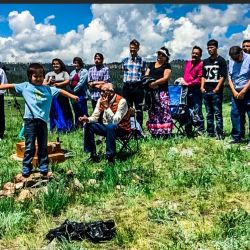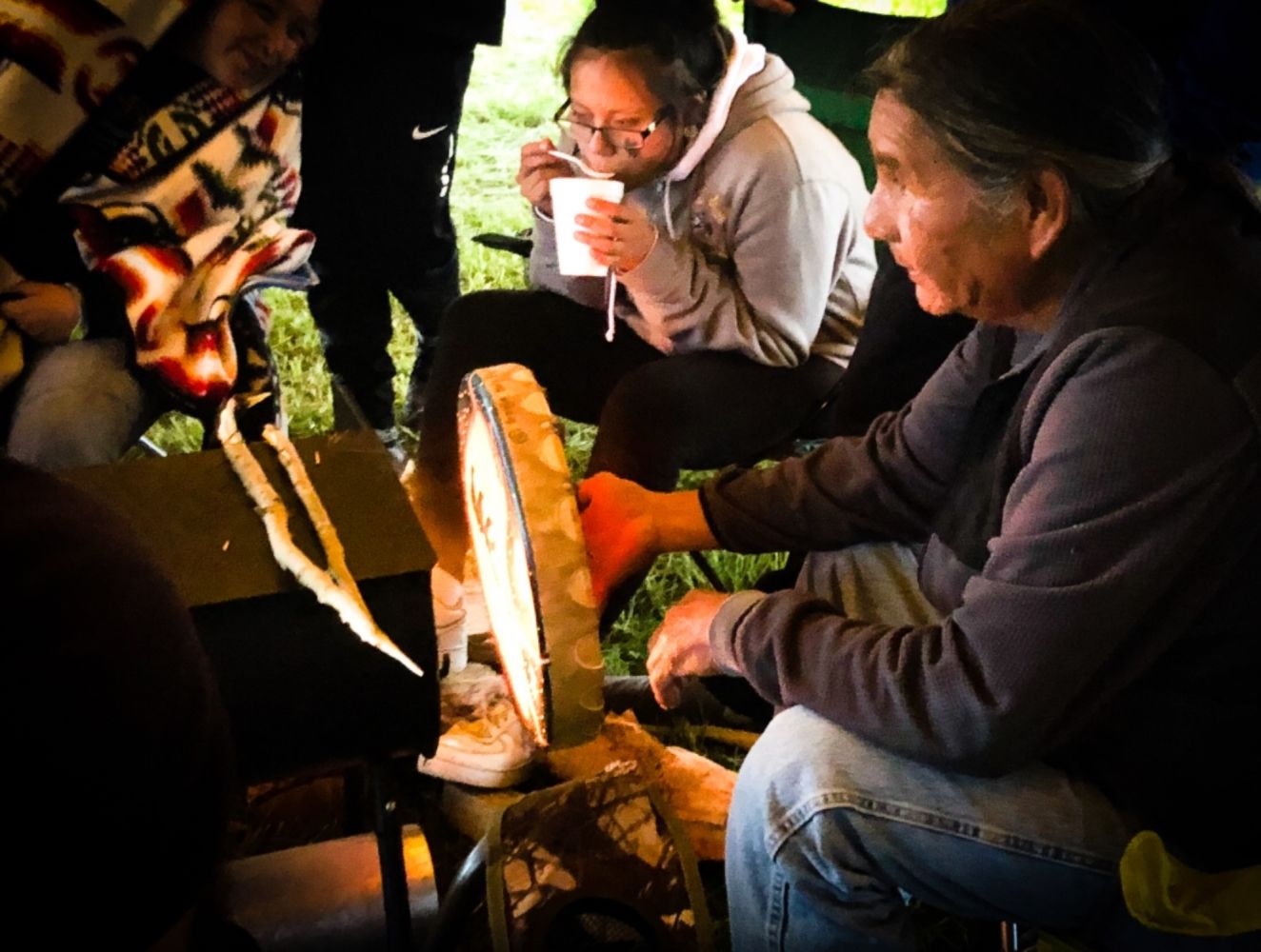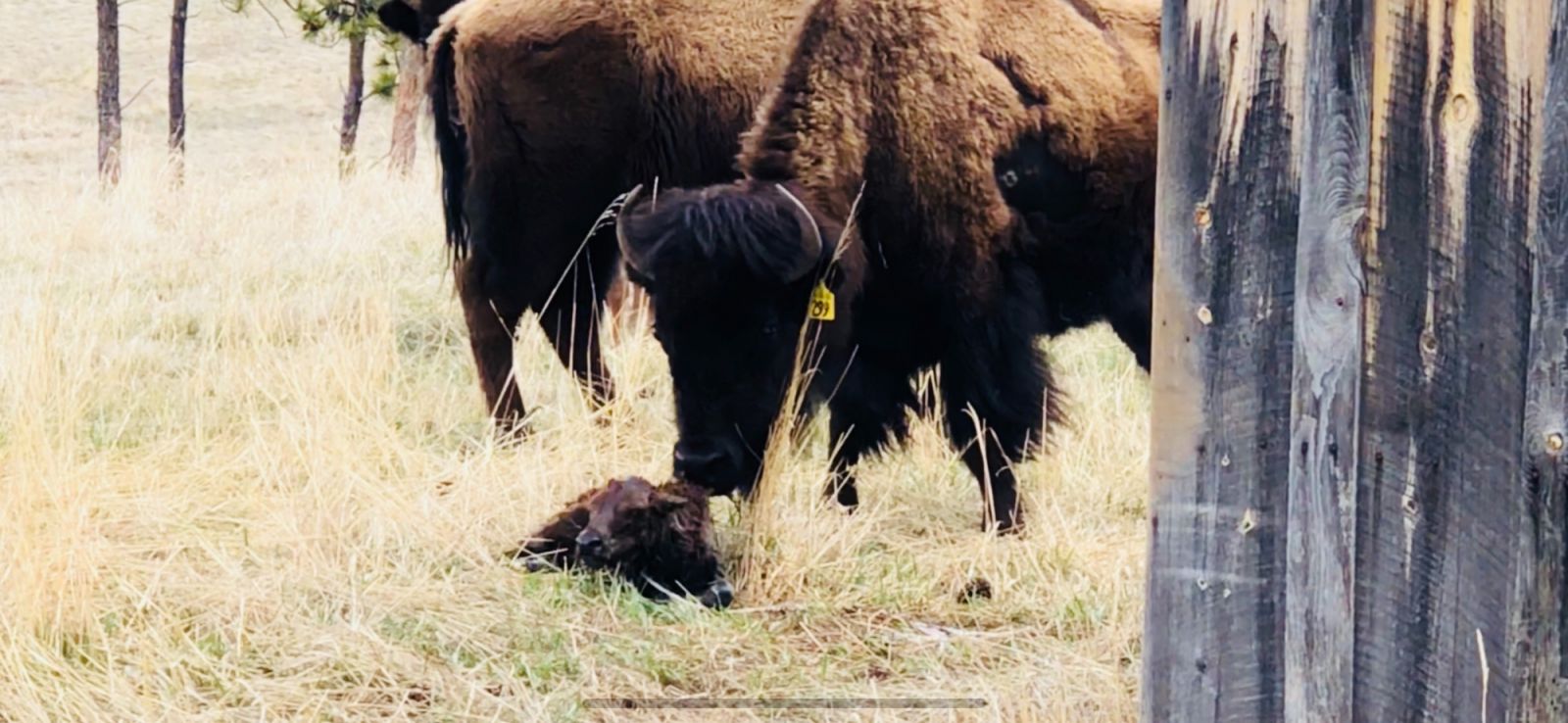Our Land / Bison Caretaker: Joe Buck Colombe Since 2014
Pe’ Sla
Pe Sla, Sacred Site: Oceti Sakowin Dakota—Nakota—Lakota Oyate—The Place Where the Morning Star Fell to Earth, the Place Where the Animals Return in the Spring
Working together for the Oceti Sakowin, the Seven Council Fires of the Great Sioux Nation, the Rosebud, Shakopee Mdewakanton, Crow Creek, Standing Rock, Cheyenne River, Yankton, Sisseton Wahpeton, Yankton and Oglala Sioux Tribes seek to restore Pe Sla, at the center of the Black Hills as our traditional sacred site.
Pe Sla is a high mountain prairie in the Heart of the Black Hills, with natural springs and ponds, nearby the headwaters of Rapid Creek, just north of Deerfield Lake, adjoining Flag Mountain and Hat Mountain. Pe Sla is located 17 miles west of Hill City, South Dakota. The Black Hills are central to the traditional homeland of the Great Sioux Nation, recognized by the 1851 and 1868 Sioux Nation treaties. The Black Hills were illegally taken from the Sioux Nation in violation of the Constitution of the United States and the 1851 and 1868 Sioux Nation Treaty after Custer’s defeat at the Battle of the Little Big Horn.
In the spirit of religious freedom, the Rosebud, Shakopee Mdewakanton, Crow Creek, Standing Rock, Cheyenne River, Yankton, Sisseton-Wahpeton, and Oglala Sioux Tribes joined together to protect Pe Sla, as a sacred site of the Oceti Sakowinof the Dakota—Nakota—Lakota Oyate, or Seven Council Fires of the Great Sioux Nation. The Pe Sla sacred site is where, according to Lakota spiritual tradition, the Morning Star fell to earth, killing the monsters that killed seven women. To honor the fallen, the Morning Star placed the women’s spirits into the stars at the Pleiades constellation.
Other Lakota traditions refer to the area as the Place Where the Animals Return in the Spring. Pe Sla is replete with evidence of Dakota—Nakota—Lakota camp circles and sacred ceremonial vistas. When whites moved into the area, there was a mountain of elk horns that reflect the long-time veneration as a placed infused with the natural abundance of Unci Maka, Grandmother Earth.
Every year, the People of the Dakota—Nakota—Lakota Oyate gather to perform traditional rituals and ceremonies as a way to ensure the continued well-being of all Mother Earth’s People. Other Lakota traditions refer to the area as the Place Where the Animals Return in the Spring. The Nature Conservancy identified Pe Sla as one of the “Areas of Biodiversity Significance within the Black Hills Ecoregion” due to the rare flora and fauna habitats.
Concern: Tract Housing
In 2012, the Reynolds, a family that homesteaded at Pe Sla in 1880, put 1,940 acres of the land on the auction block, and the People of the Dakota—Nakota—Lakota Oyate were very concerned that the land might be broken up into 40 acre tracts and sold as a subdivision at some future point. Tract housing would have irretrievably damaged the natural vista of Pe Sla as a sacred site. The People of the Dakota—Nakota—Lakota Oyate, Great Sioux Nation, were very concerned that the land should be preserved as a sacred site because of its traditional and cultural significance at the Heart of the Black Hills. The Black Hills are sacred and Pe Sla is tied to the Lakota Creation Story.
Accordingly, the Rosebud, Shakopee Mdewakanton, Crow Creek, and Standing Rock Sioux Tribe put together the initial effort to recover 1,940 acres. Later, 80 contiguous acres were added to the Pe Sla sacred site, and the initial 2,022 acres were taken into trust by the Secretary of the Interior as undivided interests for the aforementioned Sioux Tribes to protect Pe Sla as a sacred site of the Oceti Sakowin of the Dakota—Nakota—Lakota Oyate for now and for future generations of our People.
In the Secretary of the Interior’s decision to take the land at Pe Sla into trust, restoring its Indian Country status, the Assistant Secretary for Indian Affairs wrote:
The Tribes explain that Pe Sla is “innately tied” to their creation and existence. Their application reveals that PeSla is one of their “most precious sacred sites … in the heart of everything that is, in the middle of the place where [they] originate from, and is central to their existence. A study of the Property … performed by a group of Lakota, Dakota, and Nakota has identified 484 traditional cultural properties, 5 historic sites, 3 archaeological sites, and 4 undisturbed cultural sites within Pe Sla.
Under the Interior trust decision, dated December 2, 2016, PeSla “will be governed by the same laws that govern other trust land.”
Further Recovery of Sacred Lands at Pe Sla
In 2015, the Sioux Nation tribes acquired an additional 437 acres at Pe Sla from the Reynolds family, and the Cheyenne River, Yankton, Sisseton—Wahpeton, and Oglala Sioux Tribes joined the effort to preserve Pe Sla as a sacred site of the OcetiSakowin of the Dakota—Nakota—Lakota Oyate. In 2018, with the support of the San Manuel Band of Mission Indians, the Sioux Nation tribes acquired an additional 175 acres at Pe Sla from Borderlands Ranch.
Conservation Herd: Restoration of the Pte Oyate, Buffalo Nation
With the recovery of Pe Sla as a sacred site of the OcetiSakowin of the Dakota—Nakota—Lakota Oyate, the Sioux Nation tribes determined to preserve the area in its natural condition as a saced site for traditional ceremonies and youth cultural instruction, to provide a haven for native wildlife and plants, and to restore the Buffalo.
• Tatanka—the American Buffalo(Bison) is the largest herbivore of the American Great Plains. As a gift from Mother Earth, there were 60 million Buffaloon the Great Plains to provide for the Lakota—Nakota—Dakota Oyateand our neighboring Native Nations. By the close of the 19th Century, the Army and the Railroads hunted the Buffaloto near extinction. A few foundation herds were preserved, and today, the Buffaloare beginning to recover. As Native peoples, we are committed to the recovery, survival, health and well-being of Tatanka, the Buffalo.
• Sacred Animal—Our Lakota—Nakota—Dakota Oyatebelieve that we emerged from Mother Earth at Wind Cave in the Black Hills. When we emerged onto the prairie, our people were suffering, and Tatanka, the Chief of the BuffaloOyate, offered themselves so that the people might live. Today, our sacred duty as Lakota is to restore the Buffalo to health, including an effort to restore the Buffaloto their natural state, with native grasses, flora and fauna on our sacred lands in the Black Hills.
• Sacred Mission—Our mission is to preserve and restore PeSla in its natural condition, with buffalo, native grasses, native flora and fauna, and preserve the area for traditional ceremonies, community and youth activities for now and for the future generations.
• Conservation BuffaloHerd—Our Pe Sla BuffaloHerd is the foundation of a conservation herd, formed to preserve the Buffaloin its natural condition with respect for its inherent dignity and sacred nature. The Pe Sla Herd will generate breeding animals and serve as the hub of the medicine wheel to raise a pure Buffalobreeding animal for our Sioux Nation tribes, the American people and the world. Our PeSla Buffaloes will be traded as breeding animals to improve the herd and generate revenue to care for the Buffaloandour sacred sites. Revenue will be reinvested in the recovery of sacred sites and Buffalopasture in the Black Hills and the 1851 and 1868 Sioux Nation treaty lands.
• Fencing and Infrastructure. The Bureau of Indian Affairs has provided $600,000 in grants and financial support for Buffalo fencing and equipment at Pe Sla, and the USDA NRCS has provided $140,000 for fencing and water systems. Accordingly, most of the perimeter of Pe Sla has been fenced and interior pasture fences are being worked on and water systems are being improved and restored.
In 2016, the Sioux Nation tribes began to restore Buffalo to PeSla, with the assistance of the Inter-Tribal Buffalo Council in securing a donation of 12 head of Buffalo from Theodore Roosevelt National Park. In 2018, the Sioux Nation tribes received a donation of 20 Buffalo from the Oglala Sioux Tribe and a donation of 25 Buffalo from the American Prairie Reserve.
Conclusion—Preserving Pe Sla as a Sacred Site: A Model for the Future
The Sioux Nation tribes have come together to preserve PeSla as a sacred site for Working together for the Oceti Sakowin, the Seven Council Fires of the Great Sioux Nation, the Rosebud, Shakopee Mdewakanton, Crow Creek, Standing Rock, Cheyenne River, Yankton, Sisseton Wahpeton, Yankton and Oglala Sioux Tribes seek to restore Pe Sla, at the center of the Black Hills as our traditional sacred site.
The Sioux Nation tribes have been supported by the Indian Land Tenure Foundation (ILTF) with fund-raising and financial management. The Sioux Nation tribes have hired a Buffalo manager, who lives on site. Today, there are 60 Buffalo at PeSla and with natural increase, the Sioux Nation tribes expect to increase the herd to 85 Buffalo in the Spring of 2019. With the current land area, 2,612 acres, Pe Sla can support approximately 120 Buffalo.
During the process of recovering Pe Sla as a sacred site, the Sioux Nation tribes have maintained important relationships among the Sioux Nation tribes, built new relationships with the BIA, USDA NRCS, the State and Pennington County, among others.
Accordingly, the recovery of Pe Sla as a sacred site of the Oceti Sakowin of the Dakota—Nakota—Lakota Oyate, the Seven Council Fires of the Great Sioux Nation, the Sioux Nation tribes are addressing a small part of a monumental historical injustice—the illegal taking of the Black Hills—and providing a model for future restorative justice. Pe Sla also provides a model for preservation and restoration of a sacred site, and conservation of a naturally wild area for native sacred animals and plants.
When the Friendly People of the Seven Council Fires pray, we close our prayers by saying Hau, Mitaukuye Oyasin, giving homage to the Creator, Mother Earth and all Living Things as our Relatives. Working together, the Sioux Nation tribes have restored Pe Sla as a sacred site of our Native Universe.
--
Joe Buck
Pe’ Sla - Bison/Land Operator
Rosebud Sioux Tribe Utilities Commissioner
22925 S. Rochford Rd
Hill City, South Dakota
57745
joecolombe@gmail.com
(605) 828-5163
2019 Upcoming Pe’ Sla Youth Camp
For dates, additional information.
CONTACT:
Tribal Historic Preservation Office: (THPO) (605)747-4255 Fax: (605)747-4211
P.O. Box 809, Rosebud, SD 57570
Ask For: Benn Rodd/Kathy Arcorn
Mention: Pe’ Sla Youth Camp




